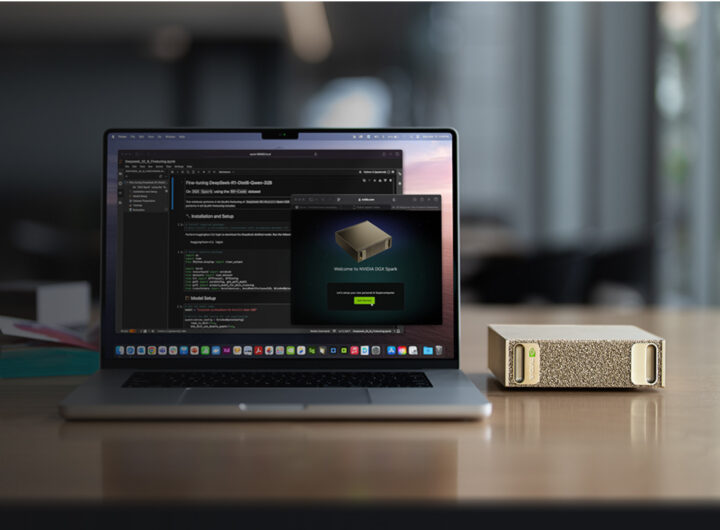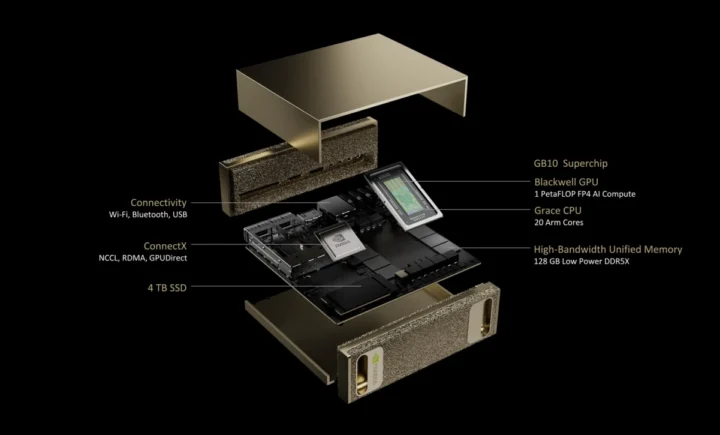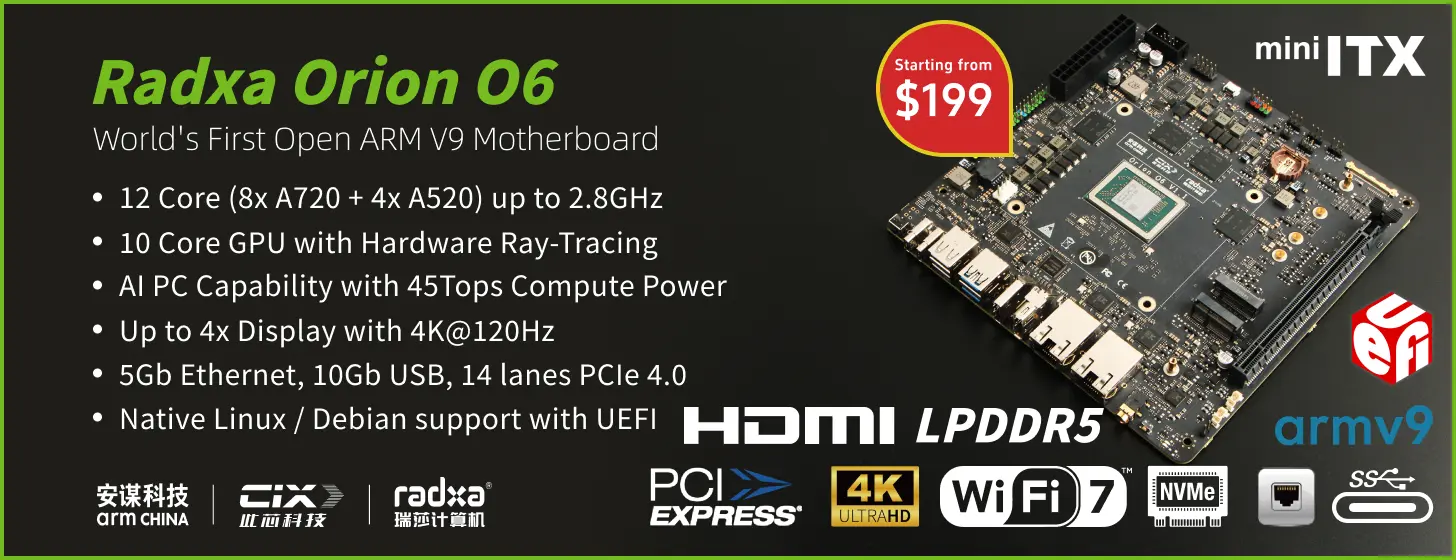NVIDIA DGX Spark may look like a mini PC, but under the hood, it’s a powerful AI supercomputer based on the NVIDIA GB10 20-core Armv9 SoC with Blackwell architecture delivering up to 1,000 TOPS (FP4) of AI performance, and high memory bandwidth (273 GB/s) with 128 GB 256-bit LPDDR5x.
The GB10 SoC is equipped with ten Cortex-X925 cores, ten Cortex-X725 cores, a Blackwell GPU, 5th Gen Tensor cores, and 4th Gen RT cores. The system also features a 1 TB or 4TB SSD, an HDMI 2.1a video output port, 10GbE and WiFi 7 networking, and four USB4 ports.
NVIDIA DGX Spark specifications:
- SoC – NVIDIA GB10
- CPU – 20-core Armv9 processor with 10x Cortex-X925 cores and 10x Cortex-A725 cores
- Architecture – NVIDIA Grace Blackwell
- GPU – Blackwell Architecture
- CUDA Cores – Blackwell Generation
- 5th Gen Tensor cores
- 4th Gen RT (Ray Tracing) cores
- Tensor Performance – 1000 AI TOPS (FP4)
- VPU – 1x NVENC, 1x NVDEC
- System Memory – 128 GB 256-bit LPDDR5x with 273 GB/s memory bandwidth
- Storage – 1 TB or 4 TB NVMe M2 SSD with self-encryption
- Display – HDMI 2.1a port
- Audio – HDMI multichannel audio output
- Networking
- 10GbE RJ45 port
- ConnectX-7 Smart NIC to connect two Spark DGX together with a speed of up to 200Gbps
- WiFi 7 and Bluetooth 5.3
- USB – 4x USB4 Type-C ports
- Power Consumption – 170 Watts
- Dimensions – 150 x 150 x 50.5 mm
- Weight – 1.2 kg
Bandwidth is critical for AI workloads, and NVIDIA further highlights that the GB10 superchip uses NVIDIA NVLink-C2C interconnect technology to deliver a CPU+GPU-coherent memory model with 5x the bandwidth of fifth-generation PCIe.
The DGX Spark runs NVIDIA DGX OS based on Ubuntu 22.04 and the company says the system supports the NVIDIA Cosmos Reason world foundation model and NVIDIA GR00T N1 robot foundation model. The NVIDIA AI platform includes tools, frameworks, libraries, and pre-trained models to allow developers to prototype, fine-tune, and inference the latest generation of reasoning AI models from DeepSeek, Meta, Google, and others with up to 200 billion parameters locally. But you can work on even larger models, as the NVIDIA Connect-X Networking can connect two NVIDIA DGX Spark systems to work with AI models up to 405 billion parameters.
Developers can reserve a DGX Spark in the US, UK, France, Italy, Germany, and Spain through partners such as ASUS, Dell, or HP. The price should be around $3,000 to $4,000 and the system will become available in May. More details can be found on the product page and the announcement which also includes the much larger DGX Station which looks like a desktop PC and delivers “data-center-level performance”.

Jean-Luc started CNX Software in 2010 as a part-time endeavor, before quitting his job as a software engineering manager, and starting to write daily news, and reviews full time later in 2011.
Support CNX Software! Donate via cryptocurrencies, become a Patron on Patreon, or purchase goods on Amazon or Aliexpress. We also use affiliate links in articles to earn commissions if you make a purchase after clicking on those links.







You should talk about Strix Halo aka Ryzen AI Max+ 395.
Well, NVDL certainly knows its marketing since on paper they claim 1000 TOPs while AMD honestly speaks only about 126 TOPs. Unfortunately AMD does not talk about width of the FP type here. NVDL claim the speed on FP4.
$3,000 to $4,000… expensive or not expensive – this is the question…
Cheap if it’s available today. Not cheap at the same price if it’s available 6mo from now, because TFLOPs are getting radically cheaper at well beyond Moore’s Law rates. Anything you buy with “AI” on it is automatically uncompetitive unless its specs continue to scale up, or its cost scales down. You need to make this pay for itself in 6-9 months as an owner. If you don’t have a use case that pays for itself in 6-9 months… use cloud services.
It’s the cheapest way to get a GPU with 128GB RAM. It’s not the fastest GPU (more like an RTX4070) nor is the RAM really fast, but if you need the RAM (e.g. for an LLM) it should be much faster than an RTX5090 in a PC with 128GB RAM..
There are of course Graphic/AI-Cards which are faster and have huge and fast local memory, but they are more in the price range of 20k$ upwards.
No it is cheaper with a mini-PC based on AMD Ryzen AI MAX+ 395 with 128GB unified memory, which while not as fast is cheaper
> 20-core Armv9 SoC
nice
>AI
>Nvidia
Nevermind…
As an ARM gaming system, it would be glorious. If there was an AAA gaming ecosystem that targeted ARM, lol.
Oculus, steamdeck, mobile
Wouldn’t mind using the m this for local deepseek or ollama for coding.
Not actually that expensive if you build a similarly specced desktop workstation.
You have a typo. Networking there is not a “10gbe via connectx7”, it is 10gbe and connectx7.
Connectx-7 is their data center NIC that (based on pictures) will provide 2 qsfp ports, at least 100gbps each (probably 200gbps, as otherwise there is no reason for going with cx7 instead of 6)
Thanks, now its fixed, though I think it is better to specify that its 200Gbps (AFAIR that is what nvidia said about it), as not everyone familiar with what is ConnectX-7 🙂
> not everyone familiar with what is ConnectX-7 🙂
Including myself 🙂 NVIDIA does not mention the speed but I added “up to 200 Gbps” to the specs…